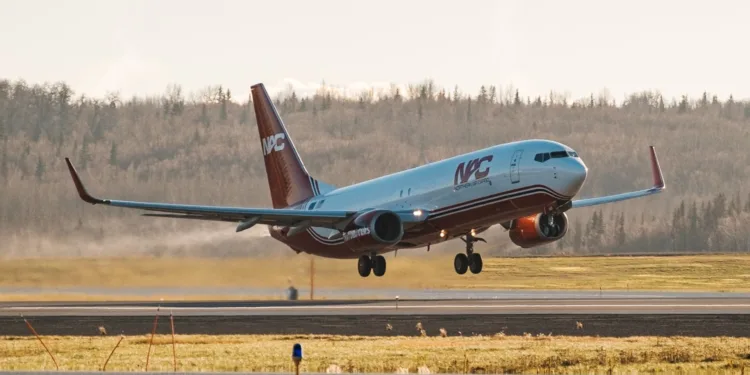Northern Air Cargo plans to start service next month to Alaska on a route dominated by Alaska Airlines as it downsizes to concentrate on core markets and stabilize finances.
The subsidiary of Seattle-based Saltchuk Resources, a freight transportation, logistics and energy distribution conglomerate, announced on Tuesday that it will launch a direct cargo route between Seattle-Tacoma International Airport and Anchorage on Oct. 5, with departures three times weekly.
The new service will utilize a Boeing 737-800 converted freighter, supplemented as needed by older 737-300 and 737-400 cargo jets.
Northern Air Cargo only operates one 737-800, which is currently providing dedicated air transportation for DHL Express on a triangle route between Los Angeles, Phoenix and Reno, Nevada. The announcement strongly suggests that DHL has not renewed the contract and that NAC is redeploying the aircraft to its core Alaska market. A company representative declined to comment on the DHL relationship.
DHL did not definitively confirm whether NAC will continue providing transportation service. “Per our corporate policy, we don’t disclose details of third-party contracts. Northern Air Cargo has been a trusted partner for several years, operating various routes within our network. We maintain close communication and value their continued support. We continually adapt our network to meet customer demand while ensuring reliable coverage across all regions we serve,” said DHLGroup spokeswoman Pamela Duque Rai via email.
A possible replacement candidate for DHL’s route is Global Crossing Airlines, which is flying an Airbus A321 converted freighter on a trial basis for the express carrier along the eastern seaboard, although neither company has indicated any expansion of the partnership so far.
Northern Air Cargo said the new route will help support rural communities and businesses in Anchorage, with the ability to deliver shipments in as little as 12 to 18 hours on a single air waybill. Shipments originating in Seattle will connect directly into the airline’s statewide network. The route also offers alternative transport for Alaskan businesses to ship fresh seafood and other goods to markets in the Pacific Northwest.
The airline currently provides scheduled and charter freight service from its Anchorage hub to communities across Alaska, delivering essential goods such as groceries, medical supplies and construction materials. Most of the cargo bound for Alaska from the Lower 48 states moves through Seattle or Tacoma, Washington, by barge, truck or air. NAC receives shipments in Anchorage and distributes them across the state.
NAC is moving into a trade lane long-dominated by Alaska Airlines, which operates three Boeing 737-700 and two 737-800 converted freighters between Anchorage, Seattle and Los Angeles, and within Alaska. The cargo jets operate three times per week from Seattle to Anchorage and the airline also moves shipments to-and-from Alaska on passenger aircraft.
“We believe there is room for another carrier in the lane. NAC’s ability to be 100% focused on the movement of cargo is a differentiator. By focusing on a smooth handoff of cargo in Anchorage and excellent communication with our customers, we believe we can offer better performance and ultimate service delivery,” said April Spurlock, director of marketing and communications, for Saltchuk Aviation, in an email exchange.
But the Trump administration’s decision in May to end the de minimis duty exemption for parcels from China under $800 in value has resulted in a significant decrease in e-commerce transshipments on Alaska Air’s northbound route from Seattle, said a former industry executive familiar with the regional market, who asked not to be identified to preserve good relations with former employers. Instead of a tight market, there is plenty of capacity available to shippers, who may feel less urgency to use an alternate carrier, he suggested.
“The current forecast is calling for volumes to increase to Alaska later this month and going forward,” Arthur Brown, president of air cargo at International Bridge, an e-commerce parcel consolidator, countered. “The Alaska freighter is a reliable, three times weekly service, but there should be ample volume to support a competitor. It will depend on the aircraft type, days of week service and price points. The key factor will be southbound support. Without anything on the return, the economics of a profitable operation will be challenging.”
Alaska Airlines media representatives didn’t respond to a query about volumes to Alaska.
NAC restructuring
NAC recently said it will stop flying its four Boeing 767-300 freighters by October and pull out of the Caribbean, Latin America and long-haul Hawaii markets by October to focus on intra-island Hawaii and Alaska service using standard-size 737 cargo jets. NAC operated the medium-widebody freighters on behalf of sister airline Aloha Air Cargo and Miami-based freight forwarder StratAir, which laid off 30 employees. In early August, Saltchuk Resources sold StratAir’s airport ground handling business.
Travis Colbert, vice president of commercial sales and commercial development at Saltchuk Aviation, announced in LinkedIn three weeks ago that he lost his job because of the company’s strategic downsizing.
The restructuring is aimed at shoring up the company’s financial performance. In 2024, cargo revenue ton miles fell nearly 10% year over year, and in the first half of this year sales are down 35%, according to the U.S. Bureau of Transportation Statistics. In the 12 months ending in March 2024, Northern Air Cargo lost about $30 million.
Click here for more FreightWaves/American Shipper stories by Eric Kulisch.
Write to Eric Kulisch at [email protected].
RELATED READING:
Northern Air Cargo abandons big freighter aircraft, cuts staff
Alaska Airlines to expand freighter service to Los Angeles
Boeing quality issue delays Alaska Airlines’ converted freighters
The post Northern Air Cargo challenges Alaska Airlines on Seattle-Anchorage route appeared first on FreightWaves.






















